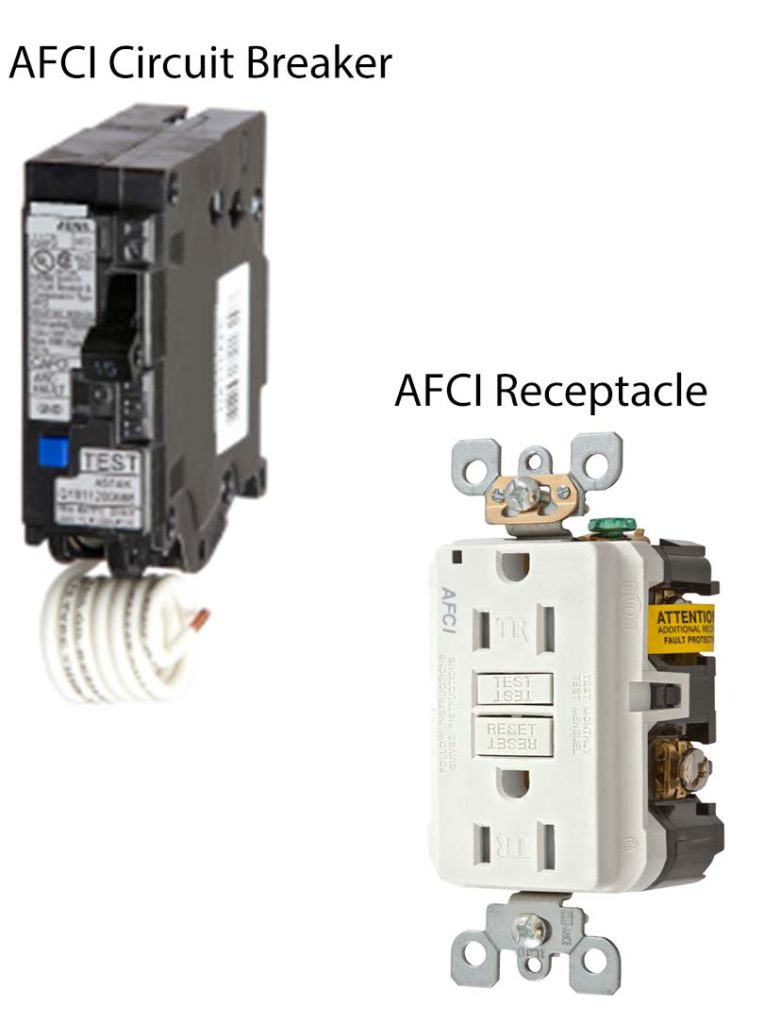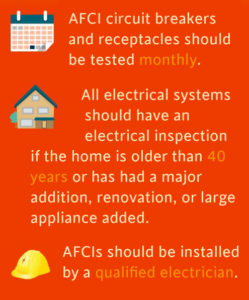Recent News:
- Download the AFCI Brochure, here.
Welcome to EFC’s Arc-Fault Circuit Interrupters (AFCIs) Information Portal. This site is dedicated to providing consumers with a general overview on Arc-Fault and the safety measures available to homeowners. The Canadian Electrical Code requires the installation of arc-fault equipment in homes to mitigate safety risks and the potential of fires. This site is supported by EFC’s Distribution Equipment and Wiring Business Sections, comprised of Canadian electrical manufacturers.
AFCIs Help Prevent Electrical Fires
As a homeowner, you have come to rely on modern technology and appliances for added comfort, convenience and energy/cost savings. While your new equipment offers plenty of benefits, it also puts increased demand on the electrical systems in your home, potentially causing serious safety risks such as arc-faults.
Arc-fault is a serious electrical issue that may result from damaged, overheated or stressed electrical wiring or devices. Arcing creates excessive heat that can easily ignite surrounding materials, such as wood framing or insulation, resulting in a potentially-hazardous fire.
Common causes of arc faults are:
- older wires that become frayed or cracked
- outlets and wires that are overloaded
- wires that are damaged or compromised (e.g. punctured by nails or screws, stapled tightly against wall studs; compressed/damaged during installation)
- the use of uncertified or counterfeit electrical products that do not meet qualified standards. (Always purchase certified electrical equipment from a licensed electrician/contractor, retailer).

The Risks are Real!
Arc-faults are the cause of a significant number of electrical fires in homes. In fact, an estimated 1,500 fires caused by electrical loss(1) were reported in Ontario over the past five years, resulting in an average of six fatalities per year (Ontario Electrical Safety Report, ESA, 2016).

![]()
![]()
1,500+ fires Average 6 fatalities/year
In the U.S., the National Fire Prevention Association (NFPA) reported that, on average each year (2010-2014), over 45,000 homes were involved in a fire caused by electrical failure or malfunction. Wiring and related equipment accounted for the vast majority of the home fires and losses (69%), and cords and plugs accounted for 10% of fires (2). A majority of the electrical failures or malfunctions are attributed to the misuse of devices, wiring, outlets, etc., or the use of uncertified, refurbished, and/or counterfeit products.
Despite these tragedies, there has been steady decline in the number of electrical-caused fires (rate decrease of 12% over the past ten years in Ontario (3). This downward trend is largely attributed to greater fire safety awareness and response, better construction materials and new fire prevention technologies like arc-fault circuit interrupters (AFCIs).
How to Protect Your Home

You can safeguard the electrical systems at home from failure or malfunction by installing certified Arc-Fault Circuit Interrupters (AFCIs) throughout your home.
AFCI technology is incorporated into specific circuit breakers and receptacle outlets and should always be installed by a licensed electrician or electrical contractor.
How does an AFCI work? AFCI circuit breakers and receptacles detect potentially-hazardous arc-fault and quickly cut off power before a fire can start. The arc-fault protection extends beyond branch circuit wiring by safeguarding all cords that are plugged into the receptacles. AFCIs are designed to protect against both high current (parallel) and low current (series) arcing.
AFCI Safety: It’s Written in the Code!
The Canadian Electrical Code requires homes to have arc-fault circuit protection installed for 125Vac, 15A and 20A circuits supplying receptacles throughout the home (with some exceptions). All new home builds are required to be AFCI code-compliant, and homeowners who are considering renovations should speak to a licensed electrician or contractor about the impact these requirements may have on their electrical system.
GFCIs vs. AFCIs: What’s the Difference?
AFCIs are a next-generation technology and arrived after the Ground-Fault Circuit Interrupters (GFCI). You will recognize GFCI receptacles in your home — these are the safety outlets in stalled in your washrooms, kitchen and other areas that can generally become wet (laundry room, outdoor spaces).
GFCI receptacles help prevent electric shock in these areas. AFCIs and GFCIs can co-exist and are a great complement for the most complete protection that can be provided on a circuit. Just as GFCIs are mandated, it is now required by law to install AFCI receptacles in rooms throughout your home or AFCI circuit breakers in your electrical panel.
Download this brochure to learn about the differences and values of these two safety technologies.
AFCI Tripping: Common Concerns & Actions
From time to time, homeowners may experience receptacle or circuit breaker trips in their home. When this happens, people often think that the AFCI device has malfunctioned. However, AFCI tripping means that the technology is working; an arcing event has been detected by the device, resulting in a circuit interruption to protect your home. If tripping events continue after you have reset the AFCI, you should call a licensed electrician to investigate.
While not a comprehensive statistical analysis of the AFCI’s currently installed in Canada, EFC conducted a confidential review of manufacturers AFCI units sold over a 4 year period and compared that data to annual tripping incidences submitted to EFC through our reporting portal. During the four-year period, on average, the tripping incidents represent .002% of total AFCIs sold in Canada.”

Take Charge of Your Home’s Safety!
Protect your home from potential fire risks with AFCI receptacles and circuit breakers with certified products that you can rely on. Speak to a licensed electrical contractor or electrician about the AFCI products available for your home.
If you have any questions, contact EFC at kewing@electrofed.com.
(1) involved some type of electrical failure or malfunction as a factor contributing to ignition.
(2) https://www.nfpa.org/media/Files/News-and-Research/Fire-statistics/Fact-sheets/ElectricalFactSheet.pdf
(3) https://www.esasafe.com/assets/files/esasafe/pdf/Safety_Reports/OESR_2016_FINAL.pdf